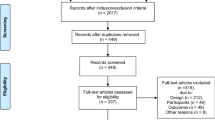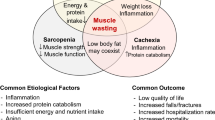Abstract
Purpose
Cachexia is associated with adverse outcomes. There is limited information on the impact of different diagnostic criteria of cachexia on patient centered outcomes.
Methods
We compared the prevalence of reduced quality of life (QoL), physical function and survival in palliative care cancer patients classified by different cachexia criteria. Four hundred and five patients with advanced cancer were included. Cachexia criteria were BMI, weight loss, fatigue, Karnofsky performance score, low handgrip strength, lean tissue depletion (DXA or arm muscle circumference) and abnormal biochemistry (inflammation, anemia or low serum albumin). QoL was assessed with a cancer specific questionnaire (EORTC QLQ-C30) and classified by cluster analysis. Dietary intake was obtained from a 4-day food record. Physical function was measured on a treadmill.
Results
Weight loss >2 %, BMI <20, fatigue and CRP >10 mg/L were associated with adverse QoL, function and symptoms (odds ratios: 2.1, 2.9, 4.0 and 3.1 respectively, P < 0.05 for all). Fatigue, low grip strength and markers of systemic inflammation were associated with short walking distance (P < 0.05). Weight loss > 2 %, fatigue, CRP > 10 mg/L and S-albumin < 32 g/L were associated with shorter survival (hazard ratios: 1.4, 1.6, 2.2 and 2.0 respectively, P < 0.05 for all). The prevalence of cachexia diagnosis varied from 12 to 85 % using different definitions.
Conclusions
Weight loss, fatigue and markers of systemic inflammation were most strongly and consistently associated with adverse QoL, reduced functional abilities, more symptoms and shorter survival. The prevalence of cachexia using different definitions varied widely; indicating a need to further explore and validate diagnostic criteria for cancer cachexia.
Similar content being viewed by others
Abbreviations
- AMC:
-
Arm muscle circumference
- ASMI:
-
Appendicular skeletal muscle mass index
- BMI:
-
Body mass index
- BW:
-
Body weight
- CRP:
-
C-reactive protein
- ED:
-
Diet energy density
- FMI:
-
Fat mass index
- EORTC:
-
European Organization for Research and Treatment of Cancer Scale
- ESR:
-
Erythrocyte sedimentation rate
- KPS:
-
Karnofsky performance score
- REE:
-
Resting energy expenditure
- QoL:
-
Quality of life
- WL:
-
Weight loss
References
Fearon K, Strasser F, Anker SD, Bosaeus I, Bruera E, Fainsinger RL, Jatoi A, Loprinzi C, MacDonald N, Mantovani G, Davis M, Muscaritoli M, Ottery F, Radbruch L, Ravasco P, Walsh D, Wilcock A, Kaasa S, Baracos VE (2011) Definition and classification of cancer cachexia: an international consensus. Lancet Oncol 12(5):489–495. doi:10.1016/S1470-2045(10)70218-7
Blum D, Omlin A, Baracos VE, Solheim TS, Tan BH, Stone P, Kaasa S, Fearon K, Strasser F (2011) Cancer cachexia: a systematic literature review of items and domains associated with involuntary weight loss in cancer. Crit Rev Oncol Hematol. doi:10.1016/j.critrevonc.2010.10.004
Tisdale MJ (2010) Cancer cachexia. Curr Opin Gastroenterol 26(2):146–151. doi:10.1097/MOG.0b013e3283347e77
Bozzetti F, Mariani L (2009) Defining and classifying cancer cachexia: a proposal by the SCRINIO Working Group. J Parenter Enter Nutr 33(4):361–367. doi:10.1177/0148607108325076
Evans WJ, Morley JE, Argiles J, Bales C, Baracos V, Guttridge D, Jatoi A, Kalantar-Zadeh K, Lochs H, Mantovani G, Marks D, Mitch WE, Muscaritoli M, Najand A, Ponikowski P, Rossi Fanelli F, Schambelan M, Schols A, Schuster M, Thomas D, Wolfe R, Anker SD (2008) Cachexia: a new definition. Clin Nutr 27(6):793–799. doi:10.1016/j.clnu.2008.06.013
Fearon KC, Voss AC, Hustead DS (2006) Definition of cancer cachexia: effect of weight loss, reduced food intake, and systemic inflammation on functional status and prognosis. Am J Clin Nutr 83(6):1345–1350
Macdonald N (2012) Terminology in cancer cachexia: importance and status. Curr Opin Clin Nutr Metab Care 15(3):220–225. doi:10.1097/MCO.0b013e328352a895
Baldwin C, Spiro A, Ahern R, Emery PW (2012) Oral nutritional interventions in malnourished patients with cancer: a systematic review and meta-analysis. J Natl Cancer Inst 104(5):371–385. doi:10.1093/jnci/djr556
Elia M, Bokhorst-de V, van der Schueren MA, Garvey J, Goedhart A, Lundholm K, Nitenberg G, Stratton RJ (2006) Enteral (oral or tube administration) nutritional support and eicosapentaenoic acid in patients with cancer: a systematic review. Int J Oncol 28(1):5–23
Lundholm K, Daneryd P, Bosaeus I, Korner U, Lindholm E (2004) Palliative nutritional intervention in addition to cyclooxygenase and erythropoietin treatment for patients with malignant disease: effects on survival, metabolism, and function. Cancer 100(9):1967–1977
Mantovani G, Maccio A, Madeddu C, Serpe R, Massa E, Dessi M, Panzone F, Contu P (2010) Randomized phase III clinical trial of five different arms of treatment in 332 patients with cancer cachexia. Oncologist 15(2):200–211. doi:10.1634/theoncologist.2009-0153
Mantovani G, Maccio A, Madeddu C, Serpe R, Antoni G, Massa E, Dessi M, Panzone F (2010) Phase II nonrandomized study of the efficacy and safety of COX-2 inhibitor celecoxib on patients with cancer cachexia. J Mol Med (Berl) 88(1):85–92. doi:10.1007/s00109-009-0547-z
Fearon KC (2008) Cancer cachexia: developing multimodal therapy for a multidimensional problem. Eur J Cancer 44(8):1124–1132. doi:10.1016/j.ejca.2008.02.033
Fearon KC, Barber MD, Moses AG, Ahmedzai SH, Taylor GS, Tisdale MJ, Murray GD (2006) Double-blind, placebo-controlled, randomized study of eicosapentaenoic acid diester in patients with cancer cachexia. J Clin Oncol 24(21):3401–3407. doi:10.1200/JCO.2005.04.5724
Fox KM, Brooks JM, Gandra SR, Markus R, Chiou CF (2009) Estimation of cachexia among cancer patients based on four definitions. J Oncol 2009:693458. doi:10.1155/2009/693458
Thoresen L, Frykholm G, Lydersen S, Ulveland H, Baracos V, Prado CM, Birdsell L, Falkmer U (2012) Nutritional status, cachexia and survival in patients with advanced colorectal carcinoma. Different assessment criteria for nutritional status provide unequal results. Clin Nutr. doi:10.1016/j.clnu.2012.05.009
Lundholm K, Daneryd P, Korner U, Hyltander A, Bosaeus I (2004) Evidence that long-term COX-treatment improves energy homeostasis and body composition in cancer patients with progressive cachexia. Int J Oncol 24(3):505–512
Daneryd P, Svanberg E, Korner U, Lindholm E, Sandstrom R, Brevinge H, Pettersson C, Bosaeus I, Lundholm K (1998) Protection of metabolic and exercise capacity in unselected weight-losing cancer patients following treatment with recombinant erythropoietin: a randomized prospective study. Cancer Res 58(23):5374–5379
Lindholm E, Daneryd P, Korner U, Hyltander A, Fouladiun M, Lundholm K (2004) Effects of recombinant erythropoietin in palliative treatment of unselected cancer patients. Clin Cancer Res 10(20):6855–6864. doi:10.1158/1078-0432.CCR-04-0373
Lundholm K, Korner U, Gunnebo L, Sixt-Ammilon P, Fouladiun M, Daneryd P, Bosaeus I (2007) Insulin treatment in cancer cachexia: effects on survival, metabolism, and physical functioning. Clin Cancer Res 13(9):2699–2706. doi:10.1158/1078-0432.CCR-06-2720
Symreng T (1982) Arm anthropometry in a large reference population and in surgical patients. Clin Nutr 1(3):211–219
Persson H, Bennegard K, Lundberg PA, Svaninger G, Lundholm K (1985) Thyroid hormones in conditions of chronic malnutrition. A study with special reference to cancer cachexia. Ann Surg 201(1):45–52
Håglin L, Hagman U, Nilsson M (1995) Evaluation of the meal model "Matmallen". A means of estimating consumed amounts of food. Scandinavian Journal of Nutrition 39:79–83
Aaronson NK, Ahmedzai S, Bergman B, Bullinger M, Cull A, Duez NJ, Filiberti A, Flechtner H, Fleishman SB, de Haes JC et al (1993) The European Organization for Research and Treatment of Cancer QLQ-C30: a quality-of-life instrument for use in international clinical trials in oncology. J Natl Cancer Inst 85(5):365–376
Scott NW FP, Aaronson NK, Bottomley A, de Graeff A, Groenvold M, Gundy C, Koller M, Petersen MA, Sprangers MAG on behalf of the EORTC Quality of Life Group (2008) EORTC QLQ-C30 reference values. http://groups.eortc.be/qol/sites/default/files/img/newsletter/reference_values_manual2008.pdf
Osoba D, Rodrigues G, Myles J, Zee B, Pater J (1998) Interpreting the significance of changes in health-related quality-of-life scores. J Clin Oncol 16(1):139–144
Quinten C, Coens C, Mauer M, Comte S, Sprangers MA, Cleeland C, Osoba D, Bjordal K, Bottomley A (2009) Baseline quality of life as a prognostic indicator of survival: a meta-analysis of individual patient data from EORTC clinical trials. Lancet Oncol 10(9):865–871. doi:10.1016/S1470-2045(09)70200-1
Trajkovic-Vidakovic M, de Graeff A, Voest EE, Teunissen SCCM (2012) Symptoms tell it all: a systematic review of the value of symptom assessment to predict survival in advanced cancer patients. Critical Reviews in Oncology/Hematology (0)
Marin Caro MM, Laviano A, Pichard C (2007) Nutritional intervention and quality of life in adult oncology patients. Clin Nutr 26(3):289–301
Wanden-Berghe C, Sanz-Valero J, Escriba-Aguir V, Castello-Botia I, Guardiola-Wanden-Berghe R (2009) Evaluation of quality of life related to nutritional status. Br J Nutr 101(7):950–960. doi:10.1017/S0007114508207178
Wallengren O, Bosaeus I, Lundholm K (2012) Dietary energy density, inflammation and energy balance in palliative care cancer patients. Clin Nutr. doi:10.1016/j.clnu.2012.05.023
Vigano A, Del Fabbro E, Bruera E, Borod M (2012) The cachexia clinic: from staging to managing nutritional and functional problems in advanced cancer patients. Crit Rev Oncog 17(3):293–304
Acknowledgements
Supported by funds for research and development in Västra Götaland, grant no. VGFOUGSB-148001, Swedish Cancer Society (2014) and the Swedish state under the ALF agreement.
Disclosure
None
Author information
Authors and Affiliations
Corresponding author
Rights and permissions
About this article
Cite this article
Wallengren, O., Lundholm, K. & Bosaeus, I. Diagnostic criteria of cancer cachexia: relation to quality of life, exercise capacity and survival in unselected palliative care patients. Support Care Cancer 21, 1569–1577 (2013). https://doi.org/10.1007/s00520-012-1697-z
Received:
Accepted:
Published:
Issue Date:
DOI: https://doi.org/10.1007/s00520-012-1697-z




